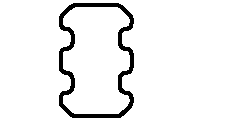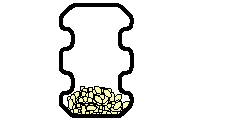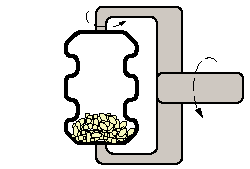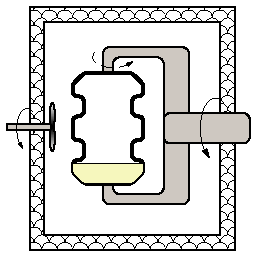Introduction to Rotational Molding
Rotational molding or rotomolding is a relatively slow process that is capable of making large one-piece hollow plastic objects at a cost lower than most other plastic molding processes.
The rotational molding process starts with a closed split mold. The molding compound, usually a thermoplastic in the form of pellets or granules, is pre-measured and loaded into the molding chamber. The chamber is then sealed and mounted on a multi-axial rotation station. The chamber is heated and the compound inside is melted. Preferably, the molten material has low viscosity and can be distributed easily. The rotation station begins to rotate slowly on multiple axes simultaneously such that the molten material is evenly coated on the internal surfaces of the mold while the temperature continues to drop in a controlled manner. The rotation and cooling continue until the molding compound solidifies. The mold can then be opened and the finished part is released.
The rotational speeds, heating and cooling rates need to be carefully controlled throughout the process. Unlike other common plastic molding methods, such as injection, extrusion, and compression moldings, there is no external pressure applied during the entire molding process. Again, this is a very slow process and each cycle usually takes about an hour or more.
 |
1.Start with a closed split mold. |
 |
2.Add molding compound. |
 |
3.Mount the mold onto a multi-axial rotation station. |
 |
4.Heat the molding compound to a liquid. A fan may be used to improve circulation and heat distribution. Rotation starts on multiple axes |
 |
5.The molten plastic coats the internal surfaces of the chamber while the mold is cooled in a controlled manner. The mold continues to rotate on multiple axes to promote even coating. Again, a fan can be used to improve circulation and cooling. |
 |
6.The rotation and cooling continue until the plastic hardens. |
 |
7.Split the mold to release the final product. |
Most thermoplastics are suitable for rotational molding:
Acrylonitrile Butadiene Styrene (ABS)
Acrylic
Polycarbonate (PC)
Polyethylene (PE)
Polypropylene (PP)
Polyester
Polystyrene (PS)
Polyvinylchloride (PVC)
Considerations for Rotational Molding
Deign Related
Sharp corners and edges should be avoided as they create stress points/lines.
Internal features need to be adequately separated (at least 3~5 times the wall thickness of the part) to allow proper melt flow.
Processe Related
The heating period should be just long enough to melt the polymer thoroughly without damaging the plastic's molecular structures.
Rapid cooling may introduce extra thermal stresses and/or shrinkages, resulting in warped parts.
Pros and Cons of Rotational Molding
Pros
One-piece product design reduces or eliminates assembly cost.
Allows complex mold split lines.
Allows molded threads and mold-in inserts.
Allows a wide range of surface finishes (textured, smooth, or polished).
Very little waste in material.
Low residual stresses. There are thermal stresses during the cooling process but (almost) no forming stresses because no external pressure is ever applied.
Tooling is less expensive. Due to its low pressure operation, the wall thickness of the molding chamber can be thinner than those for other molding methods.
Suitable for both low-volume prototypes and high-volume production runs.
Cons
Slow production speed. It usually takes about one hour to finish a cycle, as opposed to just a few seconds for a typical injection molding process.
Lower precision.

